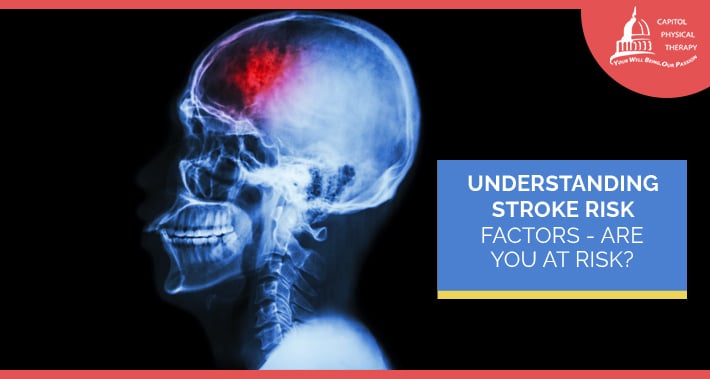
Has one of your family members had a stroke and you’re wondering if you’re at risk?
Do you want to be proactive at keeping yourself healthy?
From lifestyle to family history, there are many factors that can lead to this dangerous “brain attack.”
As physical therapists experienced in providing physical therapy for stroke recovery, we want to help people understand a little more about strokes.
In particular, find out more about the risk factors that can lead to strokes, and what you can do to help decrease your future likelihood of having one.
What Is A Stroke?
A stroke is a neurological condition that occurs when there’s an interruption to the blood flow to your brain.
There are two types of stroke: ischemic and hemorrhagic.
Ischemic stroke is the more common type and occurs when a major blood vessel in the brain has a blockage.
Hemorrhagic stroke occurs when a blood vessel in your brain bursts, spilling blood into nearby brain tissue.
In order to function, your brain needs a constant supply of oxygen and nutrients, carried by the blood vessels.
Strokes are emergencies because they interrupt this oxygen supply, which can cause brain cells to die.
When brain cells die, you lose brain function and actions controlled by the part of the brain where the stroke occurred.
This can be anything from moving and speaking to controlling your bowels.
Memory, ability to eat, emotional control, and other bodily functions can all be impeded if you have a stroke.
If you or a loved one is having a stroke, it’s important to get to an emergency room as soon as possible.
If you don’t know how to recognize a stroke, be sure to read our previous article on the topic: How To Recognize A Stroke (And Prevent A Stroke From Happening)
Modifiable Risk Factors For Stroke
The first step to reducing your risk of a stroke is to understand the risk factors that affect you.
However, there are factors you can control, and factors you cannot.
For example, if you have a parent or sibling who has previously had a stroke, especially at a young age or without many risk factors, you are more at risk.
Your risk also increases as you age.
As a result, physical therapy for seniors may involve stroke recovery physical therapy as well.
Heart disease and high blood cholesterol can also increase your risk of stroke.
Genetic risk and age aren’t things you can control, but there are other factors that you can mitigate.
These are called modifiable risk factors for stroke.
Let’s take a look at some of them.
1. Smoking Cigarettes And Other Tobacco Products
Smoking increases your chance of blood clots forming by both thickening your blood and adding to the plaque in your arteries.
If you smoke, quitting is one of the most powerful things you can do to reduce your stroke risk.
Quitting smoking isn’t easy, so check in with your doctor and don’t give up even though it can feel discouraging.
The DC Quitline is also available to help you quit smoking for good and can be reached at 1-800-QUIT-NOW (800-784-8669) or 202-333-4488 (for Spanish speakers).
Through the Quitline, DC residents can access up to 8 weeks of nicotine replacement patches or lozenges and receive one on one support sessions with certified quit coaches by phone, text messages, and web based tools.
2. Keep Your Blood Pressure Healthy
If uncontrolled, high blood pressure can double or sometimes even quadruple your stroke risk.
Monitoring your blood pressure and treating it if it’s high can make a huge impact when it comes to your risk.
In particular, obesity can lead to high blood pressure, which leads to an increased risk of stroke.
As a result, maintaining a healthy weight is not only linked with reduced stroke risk, it can also reduce your need for a number of other physical therapy services.
This is because obesity can come with a number of other health concerns as well.
At our clinic, we sometimes see obesity linked with the following treatments:
- Physical therapy for pelvic floor dysfunction in women
- Physical therapy for myofascial pain syndrome
- Physical therapy treatments for osteoarthritis
- Physical therapy treatments for hyperlordosis
- And others
To be clear – obesity doesn’t necessarily lead to the list of conditions above, nor does not being obese eliminate your risk of these factors – but they can sometimes be related.
While there are goal posts out there, it’s important to keep your weight loss goals personal to you by working with your doctor, dietitian, nutritionist, personal trainer, or other qualified healthcare provider.
In the meantime, here are some options to help you naturally lower your blood pressure:
- Reduce your salt intake – salt makes you retain water, which can add extra water to your blood, increasing the pressure on your blood vessels
- Increase the amount you exercise – this makes your heart stronger, so it can pump more blood more easily, decreasing your blood pressure
- Avoid high cholesterol foods – cholesterol can build up on the inside of your arteries, narrowing them, increasing your blood pressure, and making your heart have to work harder to push blood through them
3. Keep Your Diabetes Under Control
High blood sugar, a common hallmark of diabetes, can damage your blood vessels, which increases the likelihood of a clot forming within them.
If you have diabetes, make sure to keep your blood sugar under control by monitoring it as directed by your doctor.
Diet, medication, exercise, and seeing a diabetes physical therapist are all tools you can use to help maintain an ideal blood sugar range.

5. Maintain An Active Lifestyle
Even without the weight loss and lowered blood pressure benefits, exercise can help reduce your risk of stroke.
Exercising moderately at least five days a week is an ideal goal for you to maintain an active lifestyle.
The good news, though, is that it doesn’t have to be terribly strenuous exercise for you to benefit.
When you think of “exercise”, you might think of intense athletics, but even things like taking a walk through your neighborhood or choosing the stairs instead of the elevator at your office or home if you live in a high rise building can reduce your stroke risk while increasing your activity levels.
What To Do After A Stroke?
Stroke recovery can take weeks, months, or years depending on its severity.
There are many things you may struggle with after your stroke, such as paralysis, weakness, and coordination issues.
Numbness in your body, problems with speech, memory issues, and pain in the hands or feet are all things you might experience.
You will have to go through stroke rehabilitation to recover from your stroke, which may include speech therapy, occupational therapy, or physical therapy.
Among other treatments, seeing a physical therapist for stroke recovery can help.
Physical therapists will help you relearn the movement skills you might have lost.
They can also help reduce your risk of having another stroke.
Book Your Appointment With Capitol Physical Therapy Today
If you’re recovering after a stroke, you don’t have to go through recovery without support.
We can help you get your independence and confidence back.
Book your appointment with Capitol Physical Therapy today.
1331 H St NW #200,
Washington, DC 20005
- https://g.page/capitolptdc
9560 Pennsylvania Ave. # 202,
Upper Marlboro, MD 20772
- https://goo.gl/maps/zjL4NnnuThRhrcS86
Capitol Physical Therapy offers orthopedic and other pain related solutions, with our versitile team of physical therapists in Washington, DC